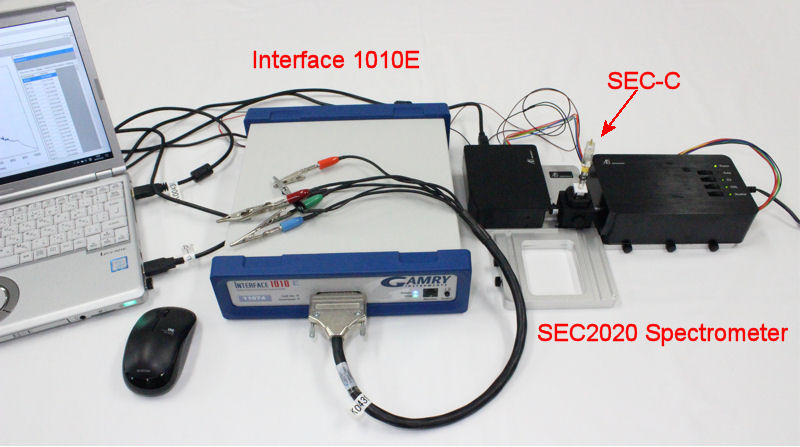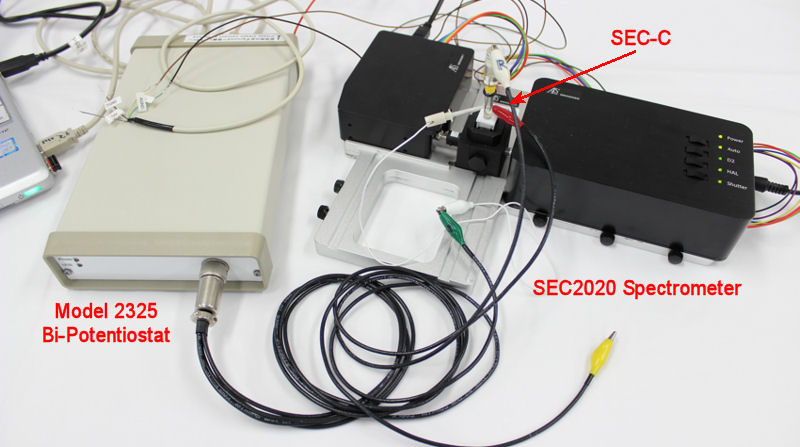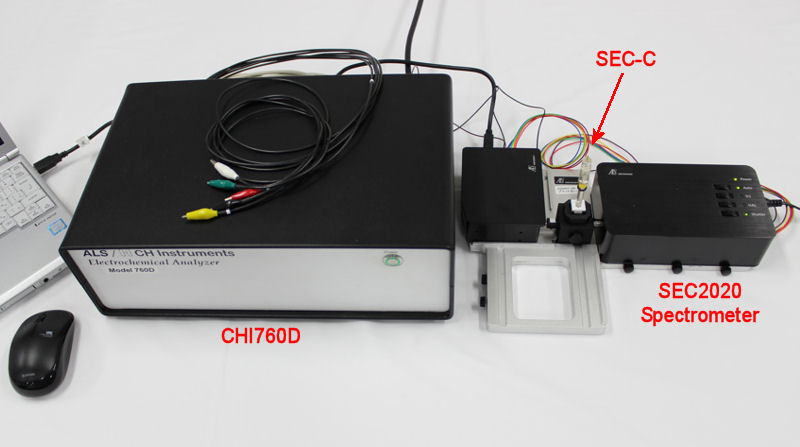SEC2020 Spectrometer system DISCONTINUED
Wide wavelength range spectrometer
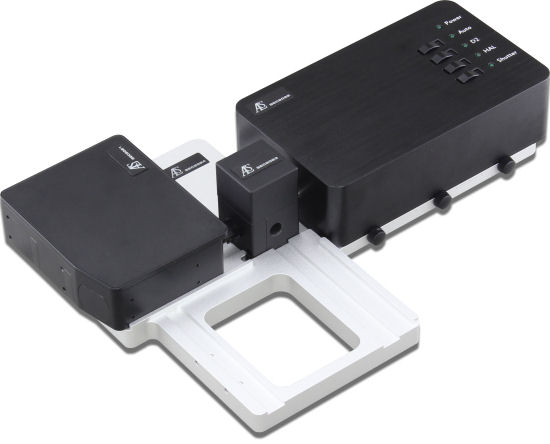
- Wide wavelength UV/VIS/NIR
- High sensitivity, resolutions and quality
- Deuterium halogen light source
- Measuring platform and analysis software included
- SMA 905 connection terminal
- Exclusive storage box
Spectroelectrochemical set up using Model 3325 Bi-Potentiostat
The SEC2020 spectrometer system is a spectrometer that enables various spectrometric measurements, focusing on spectroelectrochemical measurements. The high-performance grating and optical design, makes possible to measure with high sensitivity in a wide wavelength range, from ultraviolet to near infrared (UV/VIS/NIR), with a single unit.
For the light source, a compact modularized deuterium halogen lamp is used, which is fixed to the cell holder on the accessory platform for the measurement.
Furthermore, the spectrometer and the light source come with SMA905 connector, which makes possible to connect various optical fibers and probes, to construct the original measurement system.
Structure of SEC2020 spectrometer system
The SEC2020 spectrometer system consists of the following spectrometer, cell holder, light source, platform and collimating lens.
For spectroelectrochemical measurements and absorbance measurements, each instrument is fixed on the platform.
For measurement using immersion probe or optical fiber, you can use it by directly connection of the optical fiber to the spectrometer and light source.
The spectrometer is connected to a PC with a USB cable and controlled with Spectra Smart analysis software.

- Optical structure
- Software
- Specifications
- Application I
- Application II
- Movies
Optical structure
The optical structure of the SEC2021 Spectrometer from the SEC2020 Spectrometer System is shown below.
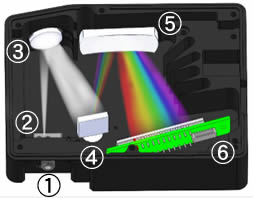
② Slit
③ Collimating mirror
④ Grating
⑤ Focus mirror
⑥ 2048 element CCD array
The SEC 2020 Spectrometer System adopts Zernitana optical mount. This system is an M-shaped structure symmetrical about the grating ④ and is an optical system with extremely small aberration.
SEC Spectra analysis software
SEC Spectra is a software program for the portable spectrometers system SEC2020 Spectrometer system.
The software is available in three languages: English, Japanese and Chinese.
• Absorbance measurement
• Reflection measurement
• Transmittance measurement
• Concentration measurement
• Relative irradiance measurement
➨ A wide range of data processing functions:
• Time-varying monitoring function
• Video capture function
• Data overwriting function
Basic software operation
Here, two examples of the software operation are brief explained, Measurement data analysis using SEC Spectra and Saving current Spectrum (Current spectrum curves as a temporary log).
Measurement data analysis using SEC Spectra
For the data analysis using the SEC Spectra, the measurement data file must be saved in a SEC Spectra's proprietary file format (extension .sps), the file in CSV or TXT format can not be analysis using the software.
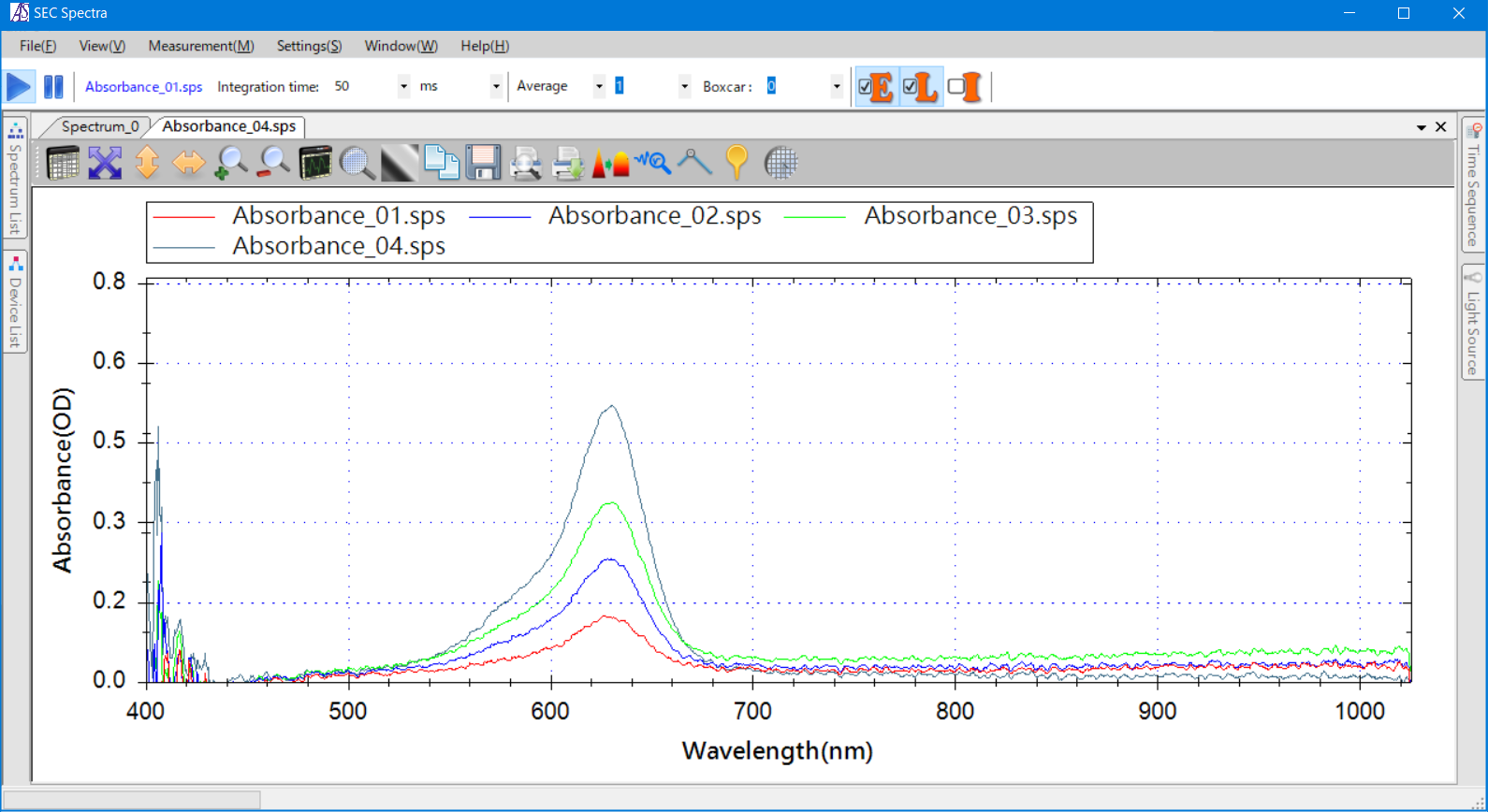

Display of the multiple spectrum in the same window, one way to compare the spectrum.
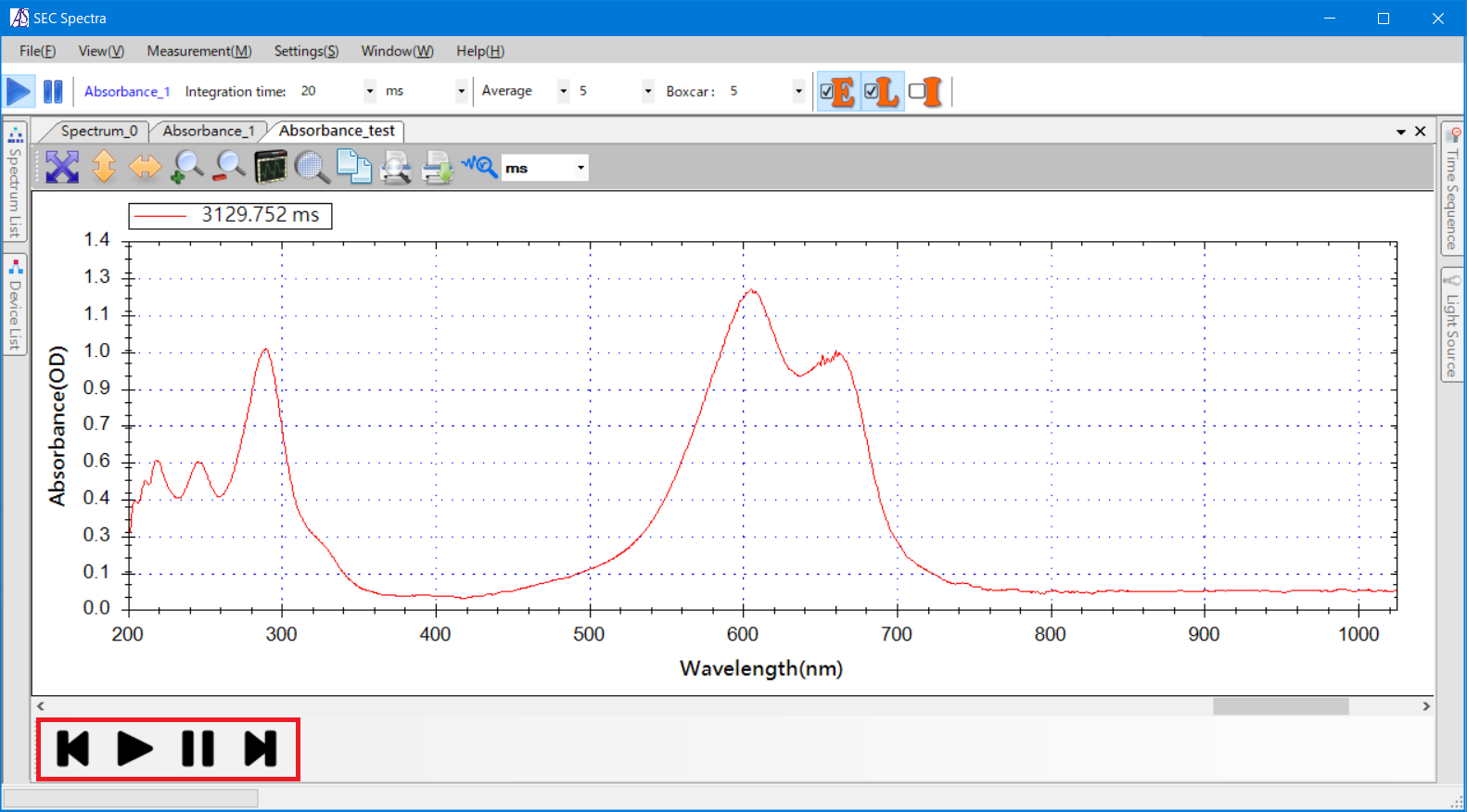

The time sequence file saved in Create file at every tracking interval can be opened, SEC Spectra will display the playback tools for the time sequence file. As shown in the left figure, there are icons that allows the user to Fast-rewind, Play, Pause, and Fast-forward the playback of time sequence. The open file will keep playing over and over again once it is loaded until Pause button is pressed.
Saving current Spectrum
Depends of the experimental requiriment, it is possible to choose from the four saving ways below:
▸ Individual Spectrum curves from the toolbar
▸ Individual Spectrum curves from the spectrum data pane
▸ All Spectrum curves in the current window
▸ Current spectrum curves as a temporary log
Below is a example for the
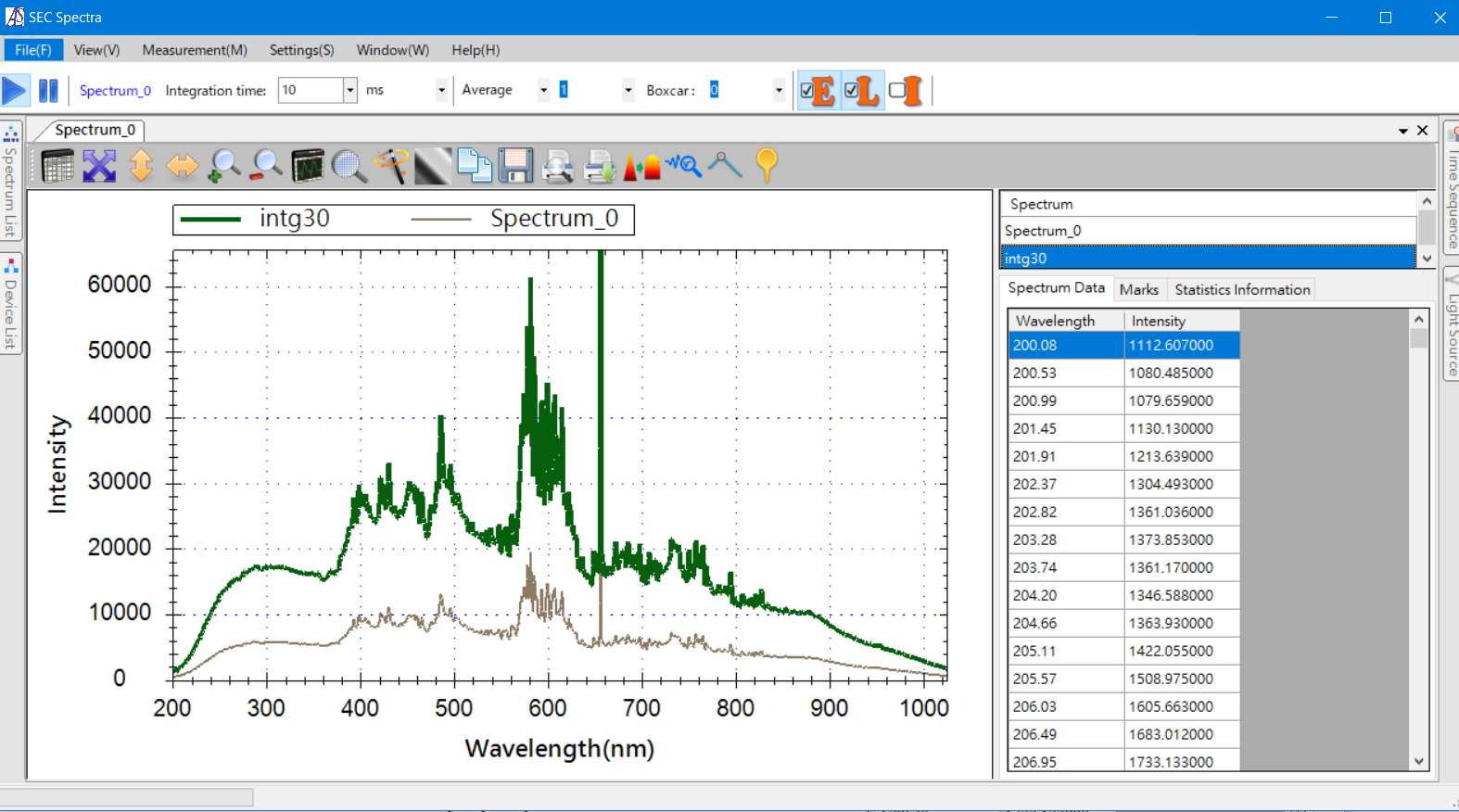

In addition to saving the spectrum as a file, SEC Spectra allows to save the spectrum curve being measured as a temporary log. The temporary log are displayed on the graph being measured, so if you change the integration time of the original Spectrum curve, the difference between the integration time of the two curves can be observed.
SEC2020 Spectrometer system specifications
| Catalog No. | Description |
| SEC2020 Spectrometer system | |
| Spectrometer specification | |
| Description | SEC2021-025-DUVN |
| Detector | 2048 element linear silicon CCD array |
| Detector range | 200 ∼ 1025 nm |
| Grating | Blaze wavelength (300 nm) |
| Slit | 25 µm |
| Wavelength resolution | 1.3 nm |
| Fiber connector | SMA905 Core diameter: 600 µm NA=0.22 |
| Interface | USB2.0 |
| Operating system | Windows 10 ∗, Windows 11 |
| Size (W×D×H) | 86×110×32 mm |
| Light source specification | |
| Description | SEC2022 |
| Light type | Deuterium halogen light source |
| Wavelength range | 200 ∼ 1700 nm |
| Stability | ‹0.1% |
| Drift | 0.25%/h |
| Bulb life | ›1000 h (D2 lamp) ⁄ ›2000h (halogen lamp) |
| Fiber connector | SMA905 |
| Power consumption | 12 DCV, 25 W |
| Size(W×D×H) | 100×165×46 mm |
| Cuvette holder | SEC2023 |
| Platform | SEC2024 |
Please refer to the Windows lifecycle fact sheet.
(Note: Windows 10 in S mode is not supported, please switch out of S mode in Windows 10.)
Application - Synchronizing EC and Spectrum
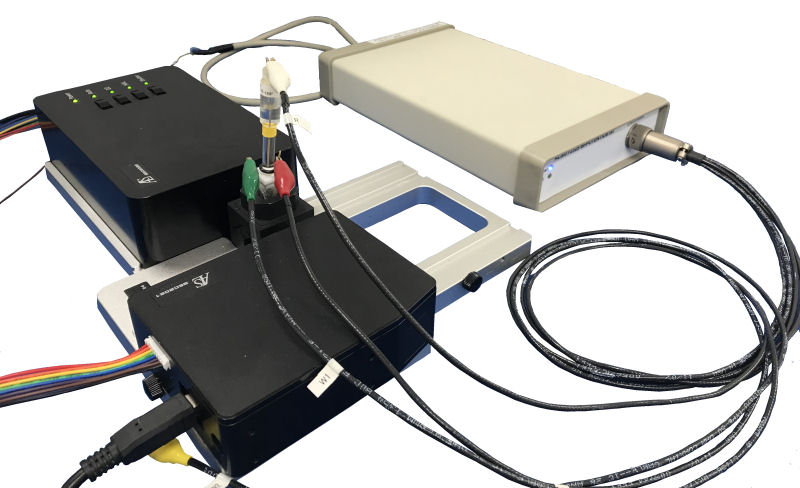
Cyclic voltammetry
and
Spectrum
Measurement
Trigger connection
The SEC2021 Spectrometer supports Trigger Mode for synchronized measurement with external device. It is a function to synchronize spectroscopic measurement and tie measurement with an external measurement.
| Pin No. | Signal | Definition | Function |
| 1 | Power | 5V Output | When connecting to the PC's USB port, this pin is connected to VBUS. Up to 100 mA current |
| 2 | No connection | ||
| 3 | No connection | ||
| 4 | Output | Shutter | Shutter ON/OFF |
| 5 | Output | D2_ON | D2 light source ON/OFF |
| 6 | Output | HAL_ON | Halogen light source ON/OFF |
| 7 | Input | Trigger-IN | TTL |
| 8 | GND | GND | Ground |
 Fig. 1 SEC2021 Spectrometer Port Pin number. |
|||
Measurement example using cuvette type spectroelectrochemical cell
UV-visible absorption spectrum and absorption change on electrode reaction can be obtained by using optically transparent electrode(OTE). Gold or Platinum mesh electrode was used as an OTE. Cyclic voltammetry and Absorbance of the 2 mM potassium ferricyanide, as the reference of the absorbance, performed in a SEC-C Thin Layer Quartz Glass Spectroelectrochemical cell are shown below.
| Electrochemistry | Spectrometry |


Fig. 1 Cyclic voltammetry for 2 mM potassium ferricyanide. |


Fig. 2 Absorption spectra of the electrolytic balance for 2 mM potassium ferricyanide electrolyzed at different potential. |
| Sample | |
| Test solution : 2 mM Potassium ferricyanide / 1 M KNO3 | |
| Measurement parameter | |
| Electrodes Working electrode: SEC-C Pt Gauze working electrode Reference electrode: RE-2BP Calomel Reference electrode Counter electrode: SEC-C Pt counter electrode Electrochemical parameters Technique: Cyclic voltammetry Initial E : +500 mV Final E : 0 mV Scan Rate (Volt) : 5 mV/S Sensitivity : 10-4 |
Setting Measurement: Spectrum Setting: Trigger (SW Level trigger) Time sequence: Sampling interval: 0.02 s Measurement time: 600 s |
Synchronized measurement
In this section connection of SEC2020 Spectrometer system with Potentiostat for a synchronized electrochemistry and spectrochemistry measurement is introduced and explained.
The spectrometer supports Trigger Mode for synchronized measurement with external device. Depending on the trigger mode, you can control acquisition of spectrometer data with external Input/Output signal. It makes possible to control the spectrometer measurement with external operation of the external devices.
As an example Interface 1010ETM (Gamry Instruments), Model 2325 Bi-Potentiostat (ALS Co., Ltd.) and Model 760D Bipotentiostat were used.
For detailed explanation, choose one of the potentiostat below:
Application - using optical fiber probes (Transmission dip probe).
Since immersion probe is measured by immersing the probe directly in the sample, troublesome sampling is unnecessary, it could amplify the experimental application field.
Reflection spectra measurement using transmission dip probe
The transmission dip probe consists of two 300 µm fibers, one is for light irradiation and the other is for detector (spectrometer).
Tips are lined up according to the optical path length, and you can choose from 2, 5, 10, and 20 mm, which is screwed to the extremity of the probe.
This probe is ideal for monitoring over time, as it does not require sampling.

① Spectrometer
② Light source
Measurement example
SEC2020 Spectrometer system with a transmission dip probe was used only to show the rapid response of the spectrum change according to the immersion to the measured solution.
2 mM Potassium ferricyanide (K3[Fe(CN)6]) in 1 M Potassium nitrate (KNO3) and 2 mM Potassium ferrocyanide (K4[Fe(CN)6]) in 1 M Potassium nitrate (KNO3), prepared on Basics of Electrochemical and Spectroelectrochemical measurements - Sample preparation was used to show the difference in the spectrum generated when immersing the probe to the solution to be measured.


Spectrum blank, without immersing to the sample.
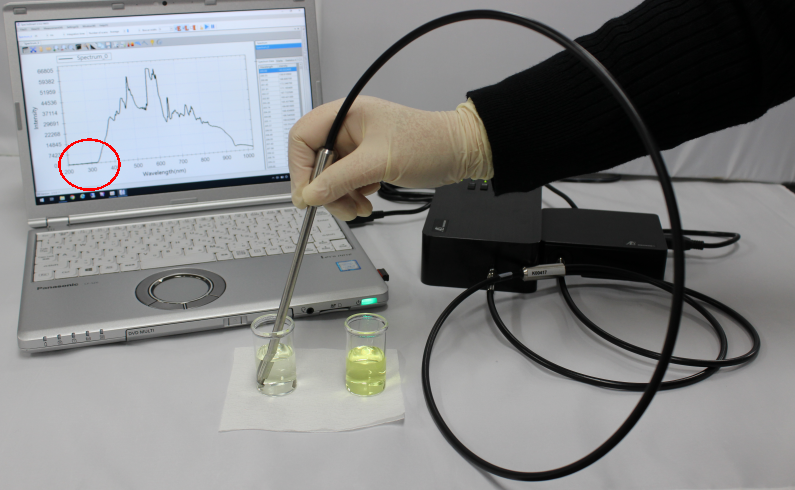

Spectrum when immersing to 2 mM Potassium ferrocyanide (K4[Fe(CN)6]) in 1 M Potassium nitrate (KNO3) solution.
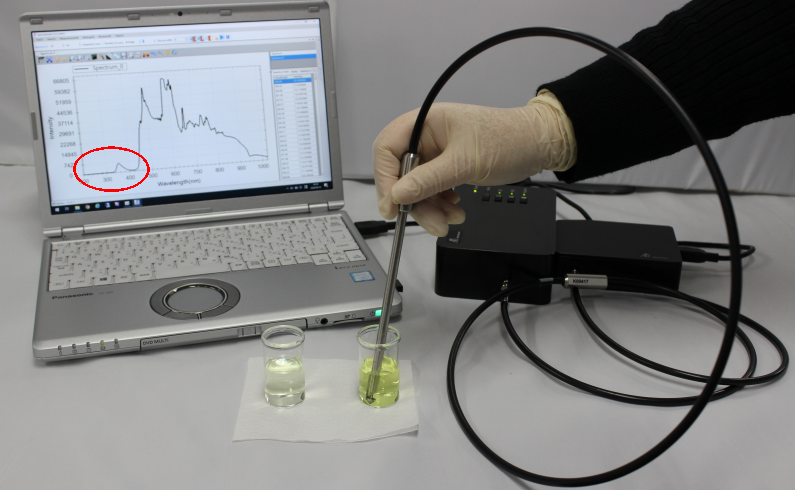

Spectrum when immersing to 2 mM Potassium ferricyanide (K3[Fe(CN)6]) in 1 M Potassium nitrate (KNO3) solution.
In this measurement Tranmission dip probe with a 10 mm Pathlength tip was used.
Accessories for SEC2020 Spectrometer
| Catalog No. | Description |  |
| 012780 | Transmission dip probe | |
| 012784 | PD-U20 20 mm tip | |
| 012781 | PD-U10 10 mm tip | |
| 012782 | PD-U5 5 mm tip | |
| 012783 | PD-U2 2 mm tip |
Movie contents
In this section introduction movies will be available gradually!
The first movie will show quickly the setup of the system, installation of the software and one standard example for the application.


